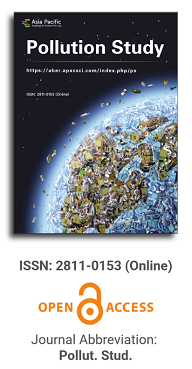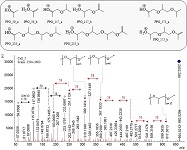
Asia Pacific Academy of Science Pte. Ltd. (APACSCI) specializes in international journal publishing. APACSCI adopts the open access publishing model and provides an important communication bridge for academic groups whose interest fields include engineering, technology, medicine, computer, mathematics, agriculture and forestry, and environment.

The (partial) replacement of synthetic polymers with bioplastics is due to increased production of conventional packaging plastics causing for severe environmental pollution with plastics waste. The bioplastics, however, represent complex mixtures of known and unknown (bio)polymers, fillers, plasticizers, stabilizers, flame retardant, pigments, antioxidants, hydrophobic polymers such as poly(lactic acid), polyethylene, polyesters, glycol, or poly(butylene succinate), and little is known of their chemical safety for both the environment and the human health. Polymerization reactions of bioplastics can produce no intentionally added chemicals to the bulk material, which could be toxic, as well. When polymers are used to food packing, then the latter chemicals could also migrate from the polymer to food. This fact compromises the safety for consumers, as well. The scarce data on chemical safety of bioplastics makes a gap in knowledge of their toxicity to humans and environment. Thus, development of exact analytical protocols for determining chemicals of bioplastics in environmental and food samples as well as packing polymers can only provide warrant for reliable conclusive evidence of their safety for both the human health and the environment. The task is compulsory according to legislation Directives valid to environmental protection, food control, and assessment of the risk to human health. The quantitative and structural determination of analytes is primary research task of analysis of polymers. The methods of mass spectrometry are fruitfully used for these purposes. Methodological development of exact analytical mass spectrometric tools for reliable structural analysis of bioplastics only guarantees their safety, efficacy, and quality to both humans and environment. This study, first, highlights innovative stochastic dynamics equations processing exactly mass spectrometric measurands and, thus, producing exact analyte quantification and 3D molecular and electronic structural analyses. There are determined synthetic polymers such as poly(ethylenglycol), poly(propylene glycol), and polyisoprene as well as biopolymers in bags for foodstuffs made from renewable cellulose and starch, and containing, in total within the 20,416–17,495 chemicals per sample of the composite biopolymers. Advantages of complementary employment in mass spectrometric methods and Fourier transform infrared spectroscopy is highlighted. The study utilizes ultra-high resolution electrospray ionization mass spectrometric and Fourier transform infrared spectroscopic data on biodegradable plastics bags for foodstuffs; high accuracy quantum chemical static methods, molecular dynamics; and chemometrics. There is achieved method performance |r| = 0.99981 determining poly(propylene glycol) in bag for foodstuff containing 20,416 species and using stochastic dynamics mass spectrometric formulas. The results highlight their great capability and applicability to the analytical science as well as relevance to both the fundamental research and to the industry.
Spatial hotspots of microplastic accumulation in sediment associated with stream outflows into lakes and estuaries
Vol 6, Issue 2, 2025
Download PDF
Abstract
Microplastics are a major form of anthropogenic pollution, and over time, the sediment at the bottom of aquatic environments becomes the sink for the denser of these particles. By mapping and analyzing sediment from lake and estuary systems, this study aimed to find spatial relationships between water and sediment dynamics at stream-to-slack-water transitions and resulting microplastic sediment accumulation characteristics. Sediment was collected along transects extending from the stream mouth to open water depositional environments at four unique study sites. After a series of separations from collected sediment, microplastics were weighed to map longitudinal variations in plastic concentration. At all study sites, the highest concentrations of microplastics (up to 14% dry weight) in sediment were found to focus in spatial hotspots peaking 600–700 m down gradient from the transition to a low-energy environment in intertidal freshwater estuary systems, and 150 m downstream in a lake system, all being associated with environments of clay-dominated sediment deposition. The dominant types of plastics identified were cellophane and polydimethylsiloxane. We hypothesize these spatial hotspots of microplastic accumulation may result from the unique diversity of density ranges for microplastic sediment, ranging from just above 1 g/cm3, but below the 2.7 g/cm3 common for natural mineral sediment, thus creating plastic depositional locations that are spatially offset from those of common mineral grains.
Keywords
References
- Karbalaei S, Hanachi P, Walker TR, et al. Occurrence, sources, human health impacts and mitigation of microplastic pollution. Environmental Science and Pollution Research. 2018; 25(36): 36046-36063. doi: 10.1007/s11356-018-3508-7
- Ritchie H, Roser M. Plastic pollution. Our World in Data; 2018.
- Rhodes CJ. Plastic Pollution and Potential Solutions. Science Progress. 2018; 101(3): 207-260. doi: 10.3184/003685018x15294876706211
- Windsor FM, Durance I, Horton AA, et al. A catchment‐scale perspective of plastic pollution. Global Change Biology. 2019; 25(4): 1207-1221. doi: 10.1111/gcb.14572
- Barboza LGA, Dick Vethaak A, Lavorante BRBO, et al. Marine microplastic debris: An emerging issue for food security, food safety and human health. Marine Pollution Bulletin. 2018; 133: 336-348. doi: 10.1016/j.marpolbul.2018.05.047
- Klein S, Dimzon IK, Eubeler J, Knepper TP. Analysis, occurrence, and degradation of microplastics in the aqueous environment. Freshwater Microplastics. 2018; 58: 51-67. doi: 10.1007/978-3-319-61615-5_3
- Zhao S, Zhu L, Wang T, et al. Suspended microplastics in the surface water of the Yangtze Estuary System, China: First observations on occurrence, distribution. Marine Pollution Bulletin. 2014; 86(1-2): 562-568. doi: 10.1016/j.marpolbul.2014.06.032
- Koutnik VS, Leonard J, Alkidim S, et al. Distribution of microplastics in soil and freshwater environments: Global analysis and framework for transport modeling. Environmental Pollution. 2021; 274: 116552. doi: 10.1016/j.envpol.2021.116552
- Smith M, Love DC, Rochman CM, et al. Microplastics in Seafood and the Implications for Human Health. Current Environmental Health Reports. 2018; 5(3): 375-386. doi: 10.1007/s40572-018-0206-z
- Zhou W, Han Y, Tang Y, et al. Microplastics Aggravate the Bioaccumulation of Two Waterborne Veterinary Antibiotics in an Edible Bivalve Species: Potential Mechanisms and Implications for Human Health. Environmental Science & Technology. 2020; 54(13): 8115-8122. doi: 10.1021/acs.est.0c01575
- Pico Y, Alfarhan A, Barcelo D. Nano- and microplastic analysis: Focus on their occurrence in freshwater ecosystems and remediation technologies. TrAC Trends in Analytical Chemistry. 2019; 113: 409-425. doi: 10.1016/j.trac.2018.08.022
- Brignac KC, Jung MR, King C, et al. Marine Debris Polymers on Main Hawaiian Island Beaches, Sea Surface, and Seafloor. Environmental Science & Technology. 2019; 53(21): 12218-12226. doi: 10.1021/acs.est.9b03561
- Andrady AL. Microplastics in the marine environment. Marine Pollution Bulletin. 2011; 62(8): 1596-1605. doi: 10.1016/j.marpolbul.2011.05.030
- Lorenz C, Roscher L, Meyer MS, et al. Spatial distribution of microplastics in sediments and surface waters of the southern North Sea. Environmental Pollution. 2019; 252: 1719-1729. doi: 10.1016/j.envpol.2019.06.093
- Claessens M, Meester SD, Landuyt LV, et al. Occurrence and distribution of microplastics in marine sediments along the Belgian coast. Marine Pollution Bulletin. 2011; 62(10): 2199-2204. doi: 10.1016/j.marpolbul.2011.06.030
- Vianello A, Boldrin A, Guerriero P, et al. Microplastic particles in sediments of Lagoon of Venice, Italy: First observations on occurrence, spatial patterns and identification. Estuarine, Coastal and Shelf Science. 2013; 130: 54-61. doi: 10.1016/j.ecss.2013.03.022
- van Emmerik T, Schwarz A. Plastic debris in rivers. WIREs Water. 2019; 7(1). doi: 10.1002/wat2.1398
- Stokes GG. On the effect of internal friction of fluids on the motion of pendulums. Transactions of the Cambridge Philosophical Society; 1850.
- Renner G, Sauerbier P, Schmidt TC, et al. Robust Automatic Identification of Microplastics in Environmental Samples Using FTIR Microscopy. Analytical Chemistry. 2019; 91(15): 9656-9664. doi: 10.1021/acs.analchem.9b01095
- Chabuka BK, Kalivas JH. Application of a Hybrid Fusion Classification Process for Identification of Microplastics Based on Fourier Transform Infrared Spectroscopy. Applied Spectroscopy. 2020; 74(9): 1167-1183. doi: 10.1177/0003702820923993
- Osman AI, Hosny M, Eltaweil AS, et al. Microplastic sources, formation, toxicity and remediation: a review. Environmental Chemistry Letters. 2023; 21(4): 2129-2169. doi: 10.1007/s10311-023-01593-3
- Díaz-Jaramillo M, Islas MS, Gonzalez M. Spatial distribution patterns and identification of microplastics on intertidal sediments from urban and semi-natural SW Atlantic estuaries. Environmental Pollution. 2021; 273: 116398. doi: 10.1016/j.envpol.2020.116398
- Coppock RL, Cole M, Lindeque PK, et al. A small-scale, portable method for extracting microplastics from marine sediments. Environmental Pollution. 2017; 230: 829-837. doi: 10.1016/j.envpol.2017.07.017
- Masura J, Baker J, Foster G, and Arthur C. Laboratory Methods for the Analysis of Microplastics in the Marine Environment: Recommendations for quantifying synthetic particles in waters and sediments. NOAA; 2015.
- Hoellein TJ, Shogren AJ, Tank JL, et al. Microplastic deposition velocity in streams follows patterns for naturally occurring allochthonous particles. Scientific Reports. 2019; 9(1). doi: 10.1038/s41598-019-40126-3
- Kooi M, Koelmans AA. Simplifying Microplastic via Continuous Probability Distributions for Size, Shape, and Density. Environmental Science & Technology Letters. 2019; 6(9): 551-557. doi: 10.1021/acs.estlett.9b00379
- Blake GR, Hartge KH. Particle Density. Methods of Soil Analysis. 2018; 377-382. doi: 10.2136/sssabookser5.1.2ed.c14
- He B, Goonetilleke A, Ayoko GA, et al. Abundance, distribution patterns, and identification of microplastics in Brisbane River sediments, Australia. Science of The Total Environment. 2020; 700: 134467. doi: 10.1016/j.scitotenv.2019.134467
- Campanale C, Stock F, Massarelli C, et al. Microplastics and their possible sources: The example of Ofanto river in southeast Italy. Environmental Pollution. 2020; 258: 113284. doi: 10.1016/j.envpol.2019.113284
- Jessieleena A, Rathinavelu S, Velmaiel KE, et al. Residential houses—a major point source of microplastic pollution: insights on the various sources, their transport, transformation, and toxicity behaviour. Environmental Science and Pollution Research. 2023; 30(26): 67919-67940. doi: 10.1007/s11356-023-26918-1
- Wypych G. Fillers – Origin, Chemical Composition, Properties, and Morphology. Handbook of Fillers; 2021. doi: 10.1016/b978-1-927885-79-6.50005-7
- Polydimethylsiloxane. American Chemical Society. Available online: https://www.acs.org/molecule-of-the-week/archive/p/polydimethylsiloxane.html (accessed on 15 January 2025).
- Tilli M, Paulasto-Kröckel M, Motooka T, et al. Handbook of Silicon Based MEMS Materials and Technologies. Elsevier Science & Technology Books: San Diego, UNITED STATES; 2010.
- Blair RM, Waldron S, Phoenix VR, et al. Microscopy and elemental analysis characterisation of microplastics in sediment of a freshwater urban river in Scotland, UK. Environmental Science and Pollution Research. 2019; 26(12): 12491-12504. doi: 10.1007/s11356-019-04678-1
- Browne MA, Galloway TS, Thompson RC. Spatial Patterns of Plastic Debris along Estuarine Shorelines. Environmental Science & Technology. 2010; 44(9): 3404-3409. doi: 10.1021/es903784e
- Saarni S, Hartikainen S, Meronen S, et al. Sediment trapping – An attempt to monitor temporal variation of microplastic flux rates in aquatic systems. Environmental Pollution. 2021; 274: 116568. doi: 10.1016/j.envpol.2021.116568
- Hayhoe K, Wake CP, Huntington TG, et al. Past and future changes in climate and hydrological indicators in the US Northeast. Climate Dynamics. 2006; 28(4): 381-407. doi: 10.1007/s00382-006-0187-8
- Cheung PK, Cheung LTO, Fok L. Seasonal variation in the abundance of marine plastic debris in the estuary of a subtropical macro-scale drainage basin in South China. Science of The Total Environment. 2016; 562: 658-665. doi: 10.1016/j.scitotenv.2016.04.048
Supporting Agencies
Copyright (c) 2025 Author(s)
License URL: https://creativecommons.org/licenses/by/4.0/

This site is licensed under a Creative Commons Attribution 4.0 International License (CC BY 4.0).
.jpg)
Beijing University of Technology, China



